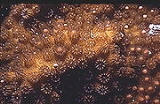
Montastraea annularis
Encyclopedia
Montastraea annularis, commonly known as the boulder star coral, is a species of coral
that lives in the western Atlantic Ocean
and is the most thoroughly studied and most abundant species of reef-building coral
in the Caribbean
to date. It also has a comprehensive fossil record within the Caribbean
. This species complex has long been considered a generalist that exists at depths between 0 and 80 meters that grew into varying colony shapes (heads, columns, plates) in response to differing light conditions. Only recently with the help of molecular techniques has M. annularis been shown to be a complex of at least three separate species. Those species are divided into M. annularis, M. faveolata, and M. franksi.
A related species is M. cavernosa, which has larger polyps.
Coral
Corals are marine animals in class Anthozoa of phylum Cnidaria typically living in compact colonies of many identical individual "polyps". The group includes the important reef builders that inhabit tropical oceans and secrete calcium carbonate to form a hard skeleton.A coral "head" is a colony of...
that lives in the western Atlantic Ocean
Atlantic Ocean
The Atlantic Ocean is the second-largest of the world's oceanic divisions. With a total area of about , it covers approximately 20% of the Earth's surface and about 26% of its water surface area...
and is the most thoroughly studied and most abundant species of reef-building coral
Coral
Corals are marine animals in class Anthozoa of phylum Cnidaria typically living in compact colonies of many identical individual "polyps". The group includes the important reef builders that inhabit tropical oceans and secrete calcium carbonate to form a hard skeleton.A coral "head" is a colony of...
in the Caribbean
Caribbean
The Caribbean is a crescent-shaped group of islands more than 2,000 miles long separating the Gulf of Mexico and the Caribbean Sea, to the west and south, from the Atlantic Ocean, to the east and north...
to date. It also has a comprehensive fossil record within the Caribbean
Caribbean
The Caribbean is a crescent-shaped group of islands more than 2,000 miles long separating the Gulf of Mexico and the Caribbean Sea, to the west and south, from the Atlantic Ocean, to the east and north...
. This species complex has long been considered a generalist that exists at depths between 0 and 80 meters that grew into varying colony shapes (heads, columns, plates) in response to differing light conditions. Only recently with the help of molecular techniques has M. annularis been shown to be a complex of at least three separate species. Those species are divided into M. annularis, M. faveolata, and M. franksi.
A related species is M. cavernosa, which has larger polyps.

